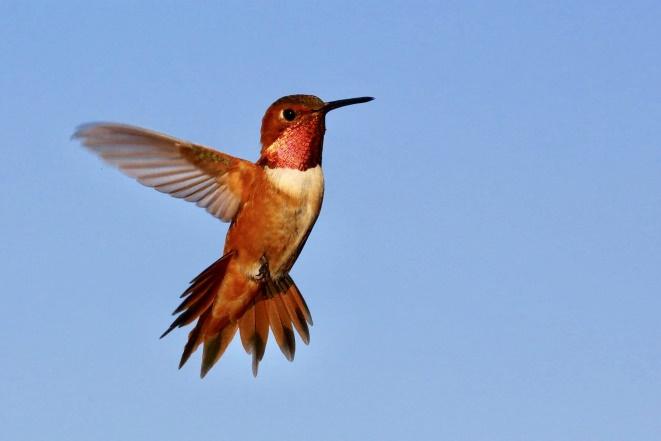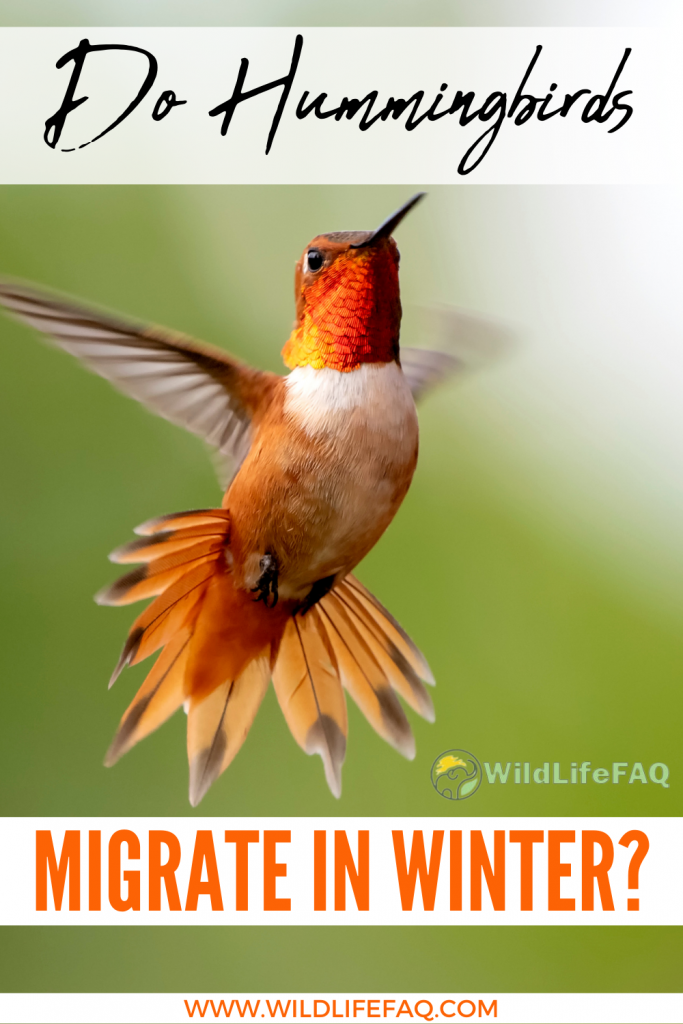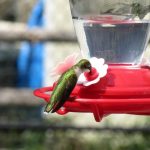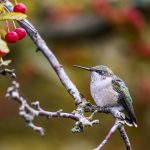Only a few hummingbird species migrate on a regular basis, despite the fact that there are over 300 species. The majority of North American hummingbirds travel between northern breeding grounds and southern wintering sites on a seasonal basis.
The majority of North American hummingbirds spend the winter in Mexico or Central America. These journeys aren’t as extensive as those undertaken by South American warblers, but they’re nonetheless noteworthy, particularly given hummingbirds’ small size.
The Ruby-throated Hummingbird, for example, is less than a penny in weight yet can fly 500 miles across the Gulf of Mexico in under a day.
What is Hummingbirds’ route of migration?
They migrate north to mating grounds in the United States and Canada in late winter and early spring.
Migration northward provides an escape from the tropics, where food competition may be severe, as well as a seat at the table, so to speak, in the north, where summer food resources are considerable.

Ruby-throated Hummingbirds may move up to 20 miles per day after they arrive in the United States.
Contrary to common belief, hummingbirds do not migrate on the backs of geese or other birds, although they may sometimes fly in mixed groups over water.
Do all Hummingbirds Fly South For The Winter?
In some conditions, like the flight across the Gulf of Mexico, they may fly for more lengthy amounts of time, like 22 hours nonstop.
While some hummingbirds begin their autumn migration as early as late July, most don’t start their trek south until August or September.
Hummingbirds are overwintering in higher numbers on the Gulf Coast than in the past, and during mild winters, many may be seen at feeders in South Texas and South Louisiana.
Several species, including the Ruby-throated, Rufous, Black-chinned, Buff-bellied, Calliope, Allen’s, Broad-tailed, and Broad-billed, are often seen in South Louisiana during the winter months.
In the warmer Pacific coastal and southern desert areas of the United States, a few hummingbird species live year-round.
What do Hummingbirds eat in the winter?
The basic recipe for hummingbird nectar is still the ideal diet for them throughout the winter months. Add sugar to boiling water in a 1:4 ratio. Once it cools, install feeders with nectar in your yard where the hummingbirds may find them. You’ll want to make some additional efforts throughout the winter to keep the hummingbird feeders warm. Prevent the mix at a 1:4 ratio and do not change it only to keep the nectar from freezing. There are other methods to achieve this that do not require modifying the hummingbirds’ diet.
What is Hummingbird’s Primary Food?
Hummingbirds feed primarily on super-sweet nectar (hummingbirds prefer nectars with more than 25% sugar content) and insects.
In reality, “hummingbirds are carnivores (nectar serves just as a source of energy for their fly-catching activities) and rely on insects that are scarce in subfreezing temperatures.” (In cold weather, nectar-bearing blooming plants are also scarce.)
Hummingbirds need a lot of food, and they do it virtually continually. Every day, they eat almost half of their body weight in pure sugar.
How Much Do They Need For Feed?

Many insects have faster metabolisms than humans. Because of their rapid metabolism, hummingbirds require a large amount of energy (calories) for their quick-winged flight, rapidly beating hearts, and even restful perching.
In fact, hummingbirds spend roughly 75% of their time perching and digesting. If less food is available in winter, then hummingbirds will die of malnutrition or cold without a fairly continuous supply of energy.
Why Do Some Hummingbirds Not Migrate?

Not all hummingbirds migrate. The major exception is Anna’s Hummingbird, which is found on the West Coast of North America, from Mexico to Southern Canada. While most other species do migrate, Anna’s hummingbird doesn’t need to.
There is generally adequate food year-round for this species, particularly since invasive plants that flower throughout winter and hummingbird feeders are becoming more popular. The idea of some hummingbird experts aside, the simple answer is survival of the fittest.
How Do Hummingbirds Know About Migration?
A hummingbird may not migrate because it’s too old, too sick, or too young, not because you are still maintaining your feeder. A hummingbird’s internal clock informs it when to depart, not the availability of nectar.

In fact, putting your feeder up helps late-departing stragglers fuel up for their trip and may also benefit those who return early when it’s still cold outdoors.
How Far North Do Hummingbirds Migrate?
Longer hours of sunshine will soon induce hormonal changes in hummingbirds that create a desire to fuel up and travel north.

Most hummingbird species breed in the U.S. and Canada winter in Mexico and Central America. Adult male hummingbirds are the first to move north to establish optimal mating territories.
Adult females are next. Hummingbirds must locate blooming flowers all along migratory routes. The Rufous Hummingbird performs a somewhat different migration.
It migrates north from Mexico to Alaska along the coast. After reproducing, it goes south, taking an internal path to take advantage of blossoming mountain wildflowers along the way.
Overall, a majority of the species of hummingbirds in North America move to warmer overwintering areas where food is available.

The Rufous Hummingbird, from its northern nesting sites in Alaska, has the longest journey of any hummingbird. It overwinters in Mexico, a distance of 4800 km (3000 miles) from Alaska.
Altitudinal migrants travel considerably shorter distances on their migratory paths.
Is It Possible to Keep Hummingbirds as Pets During Winter?
Keeping hummingbirds as pets during winter can be challenging. These tiny birds are not suited for captivity, especially in cold climates. Hummingbirds migrate to warmer regions during winter to find food and proper shelter. Attempting to keep them as pets during this time can be harmful to their health and well-being.
Do Hummingbirds Come Back To The Same Place Year After Year?
Hummingbirds do return to the same area every year, and they also come at the same time every year. According to the studies and data obtained, hummingbirds would arrive within a day or two of the previous year.
They will most surely be hunting for the feeder you hung last year. Hummingbirds recall secure and plentiful eating sites.

Scientific studies over the years have confirmed that hummingbirds indeed return to the same area every year. In addition, data obtained from bird banding projects reveals that many hummingbirds visit the same sites (feeders) on the same day, year after year.
It even demonstrates that male hummingbirds would “claim” the same region they did the year before. Females have been seen reusing the same trees for nesting and, in some circumstances, reusing their previous nest.
They come back to the same feeder they remembered from the previous year. So put your feeders out early and in the same spot and check for hummingbirds that have been “banded.”

Keywords; Ruby-throated Hummingbird, Anna’s hummingbird, Migration









